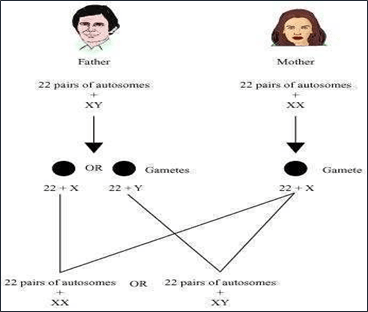NCERT Solutions for Class 10 Science Chapter 8 Heredity and Evolution includes latest edition answers of intext & exercise questions. All these NCERT solutions are prepared by expert teachers with detailed explanations of every important topic. It is important for the students to go through these NCERT solutions to get knowledge of the type of question asked on Heredity and Evolution chapter.
NCERT Solutions for Class 10 Science Chapter 8 Intext Questions
Page No. 129
Question 1: If a trait A exists in 10% of a population of an asexually reproducing species and a trait B exists in 60% of the same population, which trait is likely to have arisen earlier?
Answer: In asexual reproduction, the reproducing cells produce a copy of their DNA through some chemical reactions. However, this copying of DNA is not accurate and therefore, the newly formed DNA has some variations.
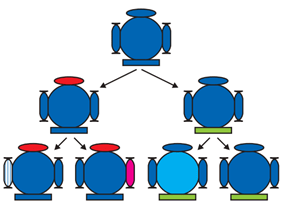
It can be easily observed in the above figure that in asexual reproduction, very few variations are allowed. Therefore, if a trait is present in only 10% of the population, it is more likely that the trait has arisen recently. Hence, it can be concluded that trait B that exists in 60% of the same population has arisen earlier than trait A.
Question 2: How does the creation of variations in a species promote survival?
Answer: Sometimes for a species, the environmental conditions change so drastically that their survival becomes difficult. For example, if the temperature of water increases suddenly, most of the bacteria living in that water will die. Only a few variants resistant to heat would be able to survive. If these variants were not there, then the entire species of bacteria would have been destroyed. Thus, these variants help in the survival of the species. However, not all variations are useful. Therefore, these are not necessarily beneficial for individual organisms.
OR
The creation of variations in a species promotes survival in several ways:
- Adaptation to Environment: Different traits mean some individuals might be better suited to survive in changing environments. For instance, animals with thicker fur in cold areas survive better.
- Disease Resistance: If a disease hits, some varied traits might make certain individuals more resistant, helping the species to continue even if many get sick.
- Reproduction Success: Variations can lead to traits that make some individuals more attractive to mates, increasing their chances of reproducing.
- Handling Different Challenges: Different challenges (like predators or climate change) can be better tackled by a diverse set of traits within a species.
Overall, variations increase a species’ chances of surviving and thriving in a changing world.
Page No. 133
Question 1: How do Mendel’s experiments show that traits may be dominant or recessive?
Answer: Mendel selected true breeding tall (TT) and dwarf (tt) pea plants. Then, he crossed these two plants. The seeds formed after fertilization were grown and these plants that were formed represent the first filial or F1 generation. All the F1 plants obtained were tall.
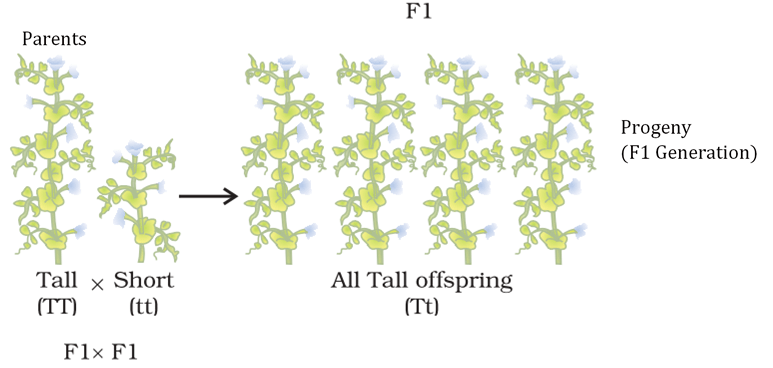
Then, Mendel self-pollinated the F1 plants and observed that all plants obtained in the F2 generation were not tall. Instead, one-fourth of the F2 plants were short.
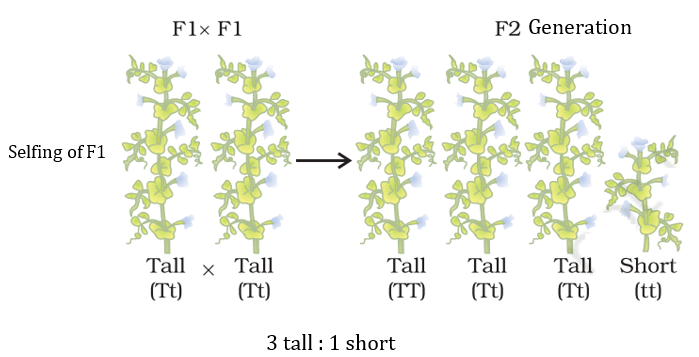
Self-pollination of F1 plants
From this experiment, Mendel concluded that the F1 tall plants were not true breeding. They were carrying traits of both short height and tall height. They appeared tall only because the tall trait is dominant over the dwarf trait.
Question 2: How do Mendel’s experiments show that traits are inherited independently?
Answer: Mendel crossed pea plants having round green seeds (RRyy) with pea plants having wrinkled yellow seeds (rrYY).
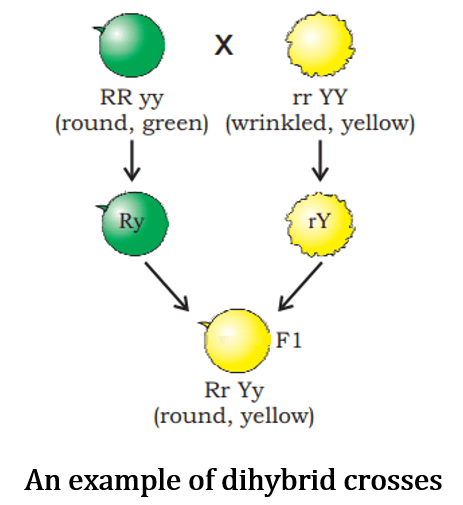
Since the F1 plants are formed after crossing pea plants having green round seeds and pea plants having yellow wrinkled seeds, F1 generation will have both these characters in them. However, as we know that yellow seed colour and round seeds are dominant characters, therefore, the F1 plants will have yellow round seeds.
Then this F1 progeny was self-pollinated and the F2 progeny was found to have yellow round seeds, green round seeds, yellow wrinkled seeds, and green wrinkled seeds in the ratio of 9:3:3:1.

In the above cross, more than two factors are involved, and these are independently inherited.
Question 3: A man with blood group A marries a woman with blood group O and their daughter has blood group O. Is this information enough to tell you which of the traits − blood group A or O − is dominant? Why or why not?
Answer: No. This information is not sufficient to determine which of the traits − blood group A or O − is dominant. This is because we do not know about the blood group of all the progeny. Blood group A can be genotypically AA or AO. Hence, the information is incomplete to draw any such conclusion.
Question 4: How is the sex of the child determined in human beings?
Answer: In human beings, the females have two X chromosomes and the males have one X and one Y chromosome. Therefore, the females are XX and the males are XY.
The gametes, as we know, receive half of the chromosomes. The male gametes have 22 autosomes and either X or Y sex chromosome.
Type of male gametes: 22+X OR 22+ Y.
However, since the females have XX sex chromosomes, their gametes can only have X sex chromosome.
Type of female gamete: 22+X
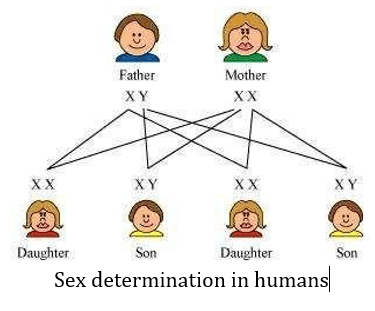
Thus, the mother provides only X chromosomes. The sex of the baby is determined by the type of male gamete (X or Y) that fuses with the X chromosome of the female.
NCERT Solutions for Class 10 Science Chapter 8 Exercise Questions
Question 1: A Mendelian experiment consisted of breeding tall pea plants bearing violet flowers with short pea plants bearing white flowers. The progeny all bore violet flowers, but almost half of them were short. This suggests that the genetic make-up of the tall parent can be depicted as
(a) TTWW
(b) TTww
(c) TtWW
(d) TtWw
Answer 1: (c) The genetic make-up of the tall parent can be depicted as TtWW.
Since all the progeny bore violet flowers, it means that the tall plant having violet flowers has WW genotype for violet flower colour. Since the progeny is both tall and short, the parent plant was not a pure tall plant. Its genotype must be Tt.
Therefore, the cross involved in the given question is
TtWw × ttww
↓
TtWw − ttww
Therefore, half the progeny is tall, but all of them have violet flowers.
Question 2: A study found that children with light – coloured eyes are likely to have parents with light coloured eyes. On this basis, can we say anything about whether the light eye colour trait is dominant or recessive? Why or why not?
Answer: Let us assume that children with light – coloured eyes can either have LL or Ll or ll genotype. If the children have LL genotype, then their parents will also be of LL genotype.
LL × LL
↓
LL
If the children with light coloured eyes have ll genotype, then their parents will also have ll genotype.
ll × ll
↓
ll
Therefore, it cannot be concluded whether light eye colour is dominant or recessive.
Question 3: Outline a project which aims to find the dominant coat colour in dogs.
Answer: Dogs have a variety of genes that govern coat colour. There are at least eleven identified gene series (A, B, C, D, E, F, G, M, P, S, T) that influence coat colour in the dogs.
A dog inherits one gene from each of its parents. The dominant gene gets expressed in the phenotype. For example, in the B series, a dog can be genetically black or brown. Let us assume that one parent is homozygous black (BB), while the other parent is homozygous brown (bb).
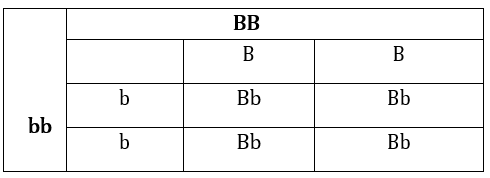
In this case, all the offsprings will be heterozygous (Bb).
Since black (B) is dominant, all the off-springs will be black. However, they will have both B and b alleles.
If such heterozygous pups are crossed, they will produce 25% homozygous black (BB), 50% heterozygous black (Bb), and 25% homozygous brown (bb) offsprings.
| 0 | B | b |
| B | BB | Bb |
| b | Bb | Bb |
Question 4: How is the equal genetic contribution of male and female parents ensured in the progeny?
Answer: In human beings, every somatic cell of the body contains 23 pairs of chromosomes. Out of these 23 pairs, the first 22 pairs are known as autosomes and the remaining one pair is known as sex chromosomes represented as X and Y.
Females have two X chromosomes and males have one X and one Y chromosome. The gamete receives half of the chromosomes. Therefore, the male gametes have 22 autosomes and either X or Y chromosome.
The female gamete, on the other hand, has 22 autosomes and the X chromosome.
During reproduction, the male and female gametes fuse and thus the progeny receives 22 autosomes and one X or Y chromosome from male parent and 22 autosomes and one X chromosome from the female parent.
